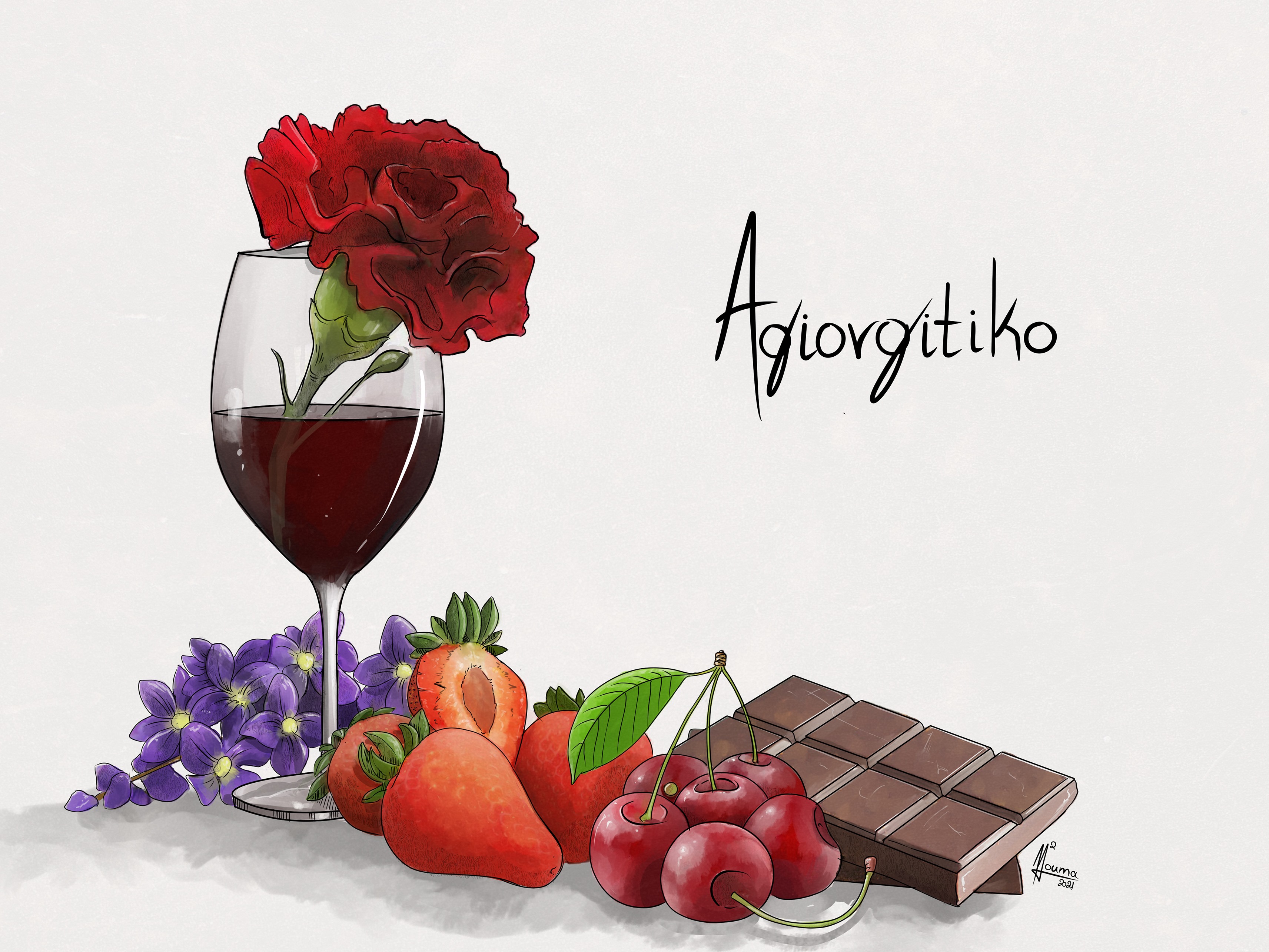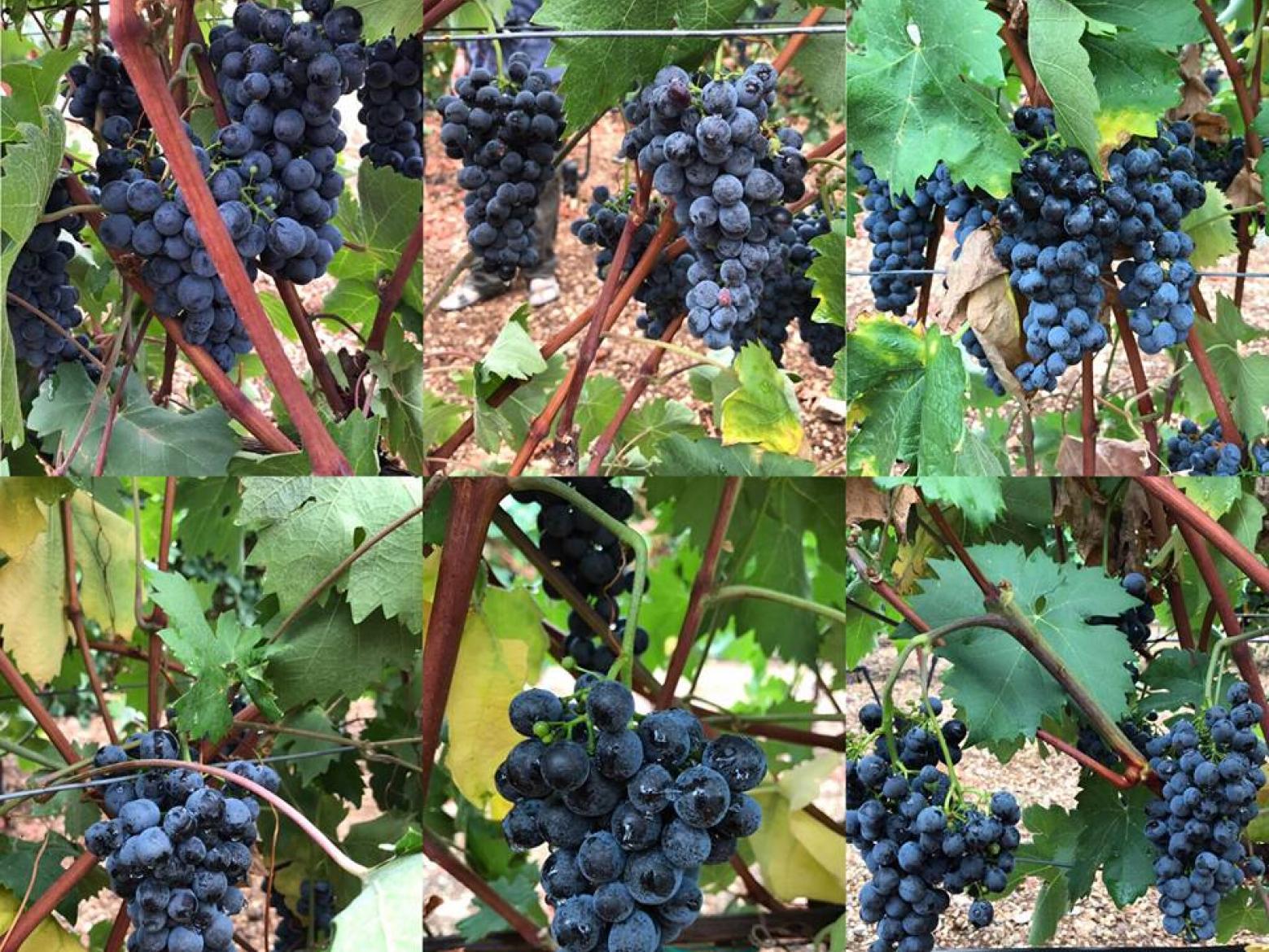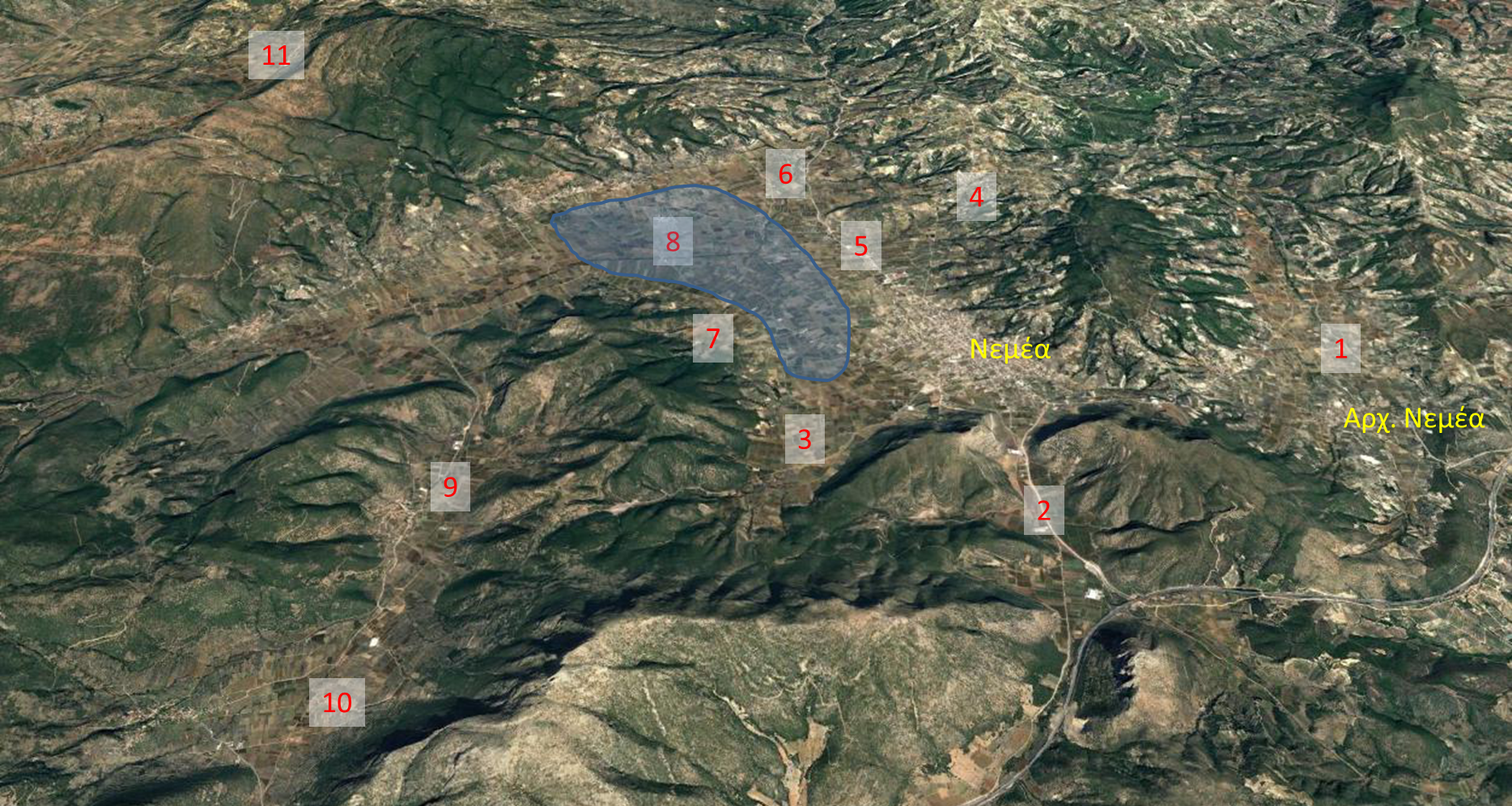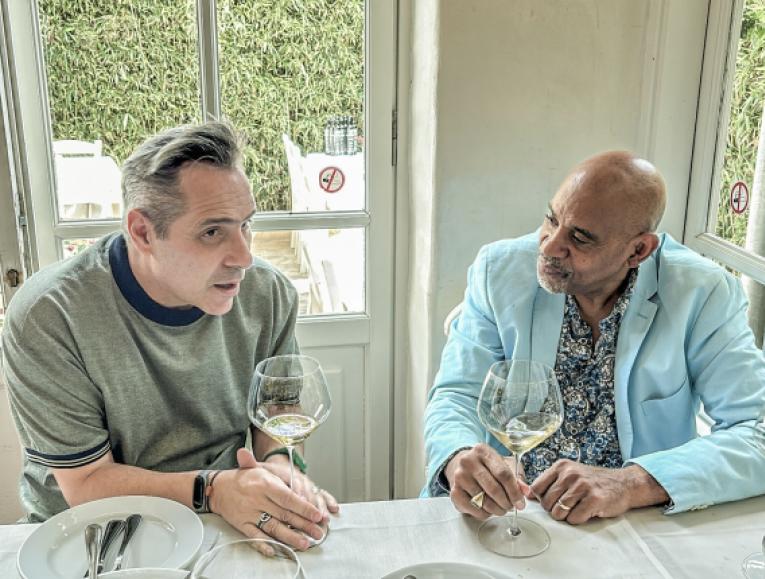
Agiorgitiko
By Yiannis Karakasis MW and Prof. Stefanos Koundouras
In a nutshell
Agiorgitiko is the most widely planted red Greek grape variety. It covers an area of 3.830 hectares, mainly in Nemea (nearly 2.500 ha) and secondarily across mainland Greece (Kavala, Drama, Attiki). According to Wine Grapes, it probably originated from Argolida and Korinthia, in the eastern part of the Peloponnese. The name refers to St George, which used to be the name of Nemea (there is a small, old church on the outskirts of the village). The Ancient Nemea village is situated on the location of the Ancient city (Nemea is a new village).
Agiorgitiko is a beautiful and charming variety with unique immediacy and balance. It defines what measure is all about, as its ingredients (fruit, acidity, tannins, alcohol) are in full harmony; also a variety that does not pretend it produces the most layered wines of the planet but instead offers lovely primary fruit and joy. If Agiorgitiko were a movie, it would have certainly been directed by Steven Spielberg, the creator of modern blockbusters.
Its classical expression is found in Nemea, though it has spread to the rest of the country giving fascinating interpretations in Drama, Kavala and mountainous Aigialeia in the Peloponnese. When Agiorgitiko producers are successful in controlling extraction and oak ageing, the result is unmatched, as it combines the deep fruity taste with a gentle, soft touch on the palate and moderate to good ageing potential.
This generally approachable and delectable expression of the variety sits across from some very artistic versions. Wines that are seriously age-worthy and the best examples can exceed ten years of bottle age. Nonetheless, the vast majority of the wines produced from Agiorgitiko are destined for a drinking window of up to six years.
In the vineyard
Agiorgitiko may also be termed Mavroudi or Mavro (Black) of Nemea. It is a late-ripening variety that ripens from mid-September onwards in the lowlands of Nemea, whereas in the highlands of Asprokambos (in Nemea) or Drama (in northern Greece) even later. It requires approximately 1800-1900 Growing Degree Days versus 2100 for Xinomavro. It is prone to fungal diseases, especially oidium (less so to downy mildew and botrytis) and is very sensitive to leafroll virus. It produces thick bunches with medium-sized berries. It can generally be considered a variety of average to good fertility, that can yield up to 120 hl/ha. Therefore, it performs better on poor soils, where its naturally high vigour can be controlled. Clonal selection is being carried out, which has selected six clones so far, but only one is commercially available at this point (for more see below).
Clones
As mentioned above, Agiorgitiko is a variety which is vigorous in its growth, susceptible to fungal diseases and late-ripening. It is usually harvested in mid-September, a period in which rainfall is a potential problem - this happened in the years 2002, 2009, 2011 and 2016. This brings us to the issue of virus-free cuttings and clonal selection; both are rather recent considerations in Greece. Nevertheless, some viticulturists can boast many years of research in this field.
For the moment six clones of Agiorgitiko have been singled out, a result of the collaborative research of the VNB nursery with IFV. One clone ENTAV INRA 1252 has already been released commercially and has been certified by the French Ministry of Agriculture; its main characteristic is that it is disease-free and that it ripens earlier (approximately two weeks). Moreover, it retains its typicity, it is productive and fruit-forward, but with 50% higher anthocyanin content and juicy tannins. This was the result of a long and demanding period of research (selecting and testing isolated clones) that lasted 15 years before a clone was achieved, with the chosen characteristics.
It is unknown when the other clones will be available. The parent material has been planted in the Alea region of Argolida at 700 m altitude. Pictures of the bunches are shown below. No.1 is on the top left, and the images are in clockwise order. A brief description of the bunches of the six different clones is given below, together with the taste of the berries of each clone, just before harvest when I first tasted them.
#1 Lots of flesh on the berries, juicy fruit, little bitterness.
#2 Smaller berries compared to #1 with higher acidity and less obvious fruit. Small bunches.
#3 Similar to #1 with fresh acidity and an overall green character. Big bunches.
#4 Compact bunches, fleshy and ripe. Moderate bunches in size.
#5 Ripe and balanced. Moderate bunches.
#6 Loose bunches, seems less vigorous and concentrated. Moderate bunches.
Terroirs of Nemea
When one talks about Nemea, it will typically be described as the largest PDO region of the country, with approximately 2.500 hectares under vine. The variety that is considered the ultimate star is, none other, than the charming Agiorgitiko, which produces soft, fruity and easy-drinking wines. This may be a statement that involves much truth, but it is not the whole truth.
Nemea is so much more; it is a mosaic of vineyards that vary in exposure, altitude and soil, and this particular assortment is expressed in the wines. They come in a wide variety of styles and qualities. One needs to walk through the vineyards and the broader area to fully grasp the diversity of the terroir. It is worth trying the wines of each locality separately to discern the breadth of all the different elements and how these are imprinted in the wines. It would not be an exaggeration if one were to say that Nemea rivals Naoussa in terms of complexity of terroirs; the difference being that Nemea producers are not crafting wine exclusively from specific terroirs or zones as they are doing in Naoussa.
Nevertheless, all this diversity has not been clearly highlighted during these recent years. Not only have these facts not been made known, but the image of Nemea has suffered. Oceans and seas of cheap, bulk wine supply armies of thirsty consumers damaging the reputation of the area, which has come to be associated with poor quality, dubious wine.
The landscape of the zone is defined by numerous valleys which have been formed by the flow of rivers, such as Asopos. These are:
1. Nemea (central plateau) with subregions like Achladias, Katsena, Galatas, Aidonia, Petri, Kalivia, Zenes, Tsidaria, Ag. Dimitrios
2. Ancient Kleones
3. Ancient Nemea
4. Leontio-Gymno
5. Asprokambos-Psari
6. Kefalari-Klimenti
7. Malandreni
8. Xirokambos
Plus Koutsi slopes, Dafni, Bozikas, Titanis
The altitude for the zone starts at 300 meters and reaches above 900 meters, but vineyards are planted up to 850 meters in Asprokambos. Close to 20% of the vineyards are at above 500 meters. The climate, although generally Mediterranean and warm with 2000 GDD in the plain (lower in the highlands) is considerably cooler than that of Naoussa, and in practice shows significant difference even within short distances because of altitude variation. Rainfall (theoretically) is at an average of 750 mm mostly (80%) during the winter months. However, it does not follow any rule; thus each vintage is affected to the maximum. There are years with minimum rainfall (2007 with 408 mm, 2008 with 515 mm, 2013 with 541 mm) and others with close to 1000 mm (908 mm in 1999, 872 mm in 2010, 826 mm in 2014). And, as if the rain were not enough of a problem, add the much desired cold nights to the equation, and this makes it all the more exciting and complicated.
The presence of clay and silt characterises the soils, but there is also limestone almost everywhere, but to a different depth, which seems to add a distinct feature to wines. Naturally, in the lowlands the soils are more fertile. In contrast, the farther one goes up to the hills, the soils become shallower, with more rocky features (best soils are found at the foothills of the slopes), and at the highest level, one encounters marl which gives excellent drainage and thus lower yields.
All of what I describe above has not been highlighted before. Everybody considers Nemea as uniform, without realising its many facets. To a certain extent, this is justified by the fact that the majority of wines are blended from several terroirs (as described above). Koutsi has been singled out, and there has been some discussion about Asprokambos and Ancient Nemea. An exciting puzzle that is worth exploring and tasting.
Let's take a look at the various terroirs.
Ancient Nemea is the second sub-region with an altitude of 330 metres. The soils are mostly clay, with limestone found at depths greater than 50 cm. It has a few slopes, and the soils are less heavy and less fertile than those of classic Nemea. It is a narrow valley north to south, with hills of both west and eastern aspect. As expected on the slopes, there is more calcium carbonate (CaCO3).
Xirokambos that can be considered an extension of Nemea is a beautiful valley, dark and late-ripening because high hills enclose it; the soils are red and clayey with good drainage, at 300-340 metres altitude. It produces aromatic expressions of the variety.
Koutsi is the most famous sub-region of Nemea with several producers producing their wine there. It has the smallest diurnal range and includes mostly western slopes that rise from 350 m to 500 m. Western exposure means heat, and there is abundant limestone at 30-40 cm under the surface. Although it has lower temperatures during the day and warmer at night, this seems to favour structure over fruit. Moreover, marl results in water stress. Koutsi probably shows more promise in vintages that struggle to ripen the grapes, whereas now with climate extremes, this more complicated.
Achladias is a recess in the plain with eastern exposure at 300 m altitude and soils that are gravelly and sandy. Soils become more rocky and coarse as one approaches the mountain.
Leontio at 350 metres above sea level is a fascinating valley with North-South direction and western slopes.
Gymno is a continuation of Leontio and starts at 370 meters and goes up to 500 meters. The slopes are gravelly with inclinations of NW aspect, one of the best areas in Argolida
Asprokambos (The other Nemea), on the other hand, starts at about 700 meters at its lowest end (fertile, limestone-free soils which are are not well-drained) with late harvests, and rises to 770 metres in Kefalari (the only acidic soils of Nemea, which are not well-drained and affect quality negatively) and 800m in Psari that has a southern exposure and is therefore favoured (considered a premium subzone due to its aspect). Especially the western slopes, that receive the afternoon sun are regarded as having more potential for the production of red wines. Asprokambos, located at about 20 km away from the centre of Nemea, is another hidden Greek terroir that deserves more attention and recognition; it possesses all the characteristics required for the production of high-quality wines. It used to be suitable only for rosés and light reds, but climate change modified styles and quality orientation. With vineyards rising to 850 m (lowest are located at 650) Asprokambos has one of the coolest mesoclimates in the country (together with Metsovo in Epirus, Amyndeon in Macedonia, and Mantinia in the Peloponnese) with a high diurnal range, about 15ºC in the winter and even 20ºC during the summer, which is crucial for the preservation of acidity and for building tannin structure. In fact, Asprokambos has approximately 300 GDD (Growing Degree Days) in the growing season less than those of classic Nemea. In summertime it is 2-3o C cooler, both in the day and night.
Having said that, if we take into account the trend of rising temperatures during the last decades, Asprokambos offers potential in dealing with the classic warm Greek summers. However, to harvest top-quality fruit September needs to be uneventful, which is not always the case as rainfall frequently occurs during this time. The very fertile soils are a challenge. Harvest takes place approximately 15 days later compared to the classic Nemea terroirs, with some hillside vineyards reaching even 14º Baumé; best terroirs are the poorer hillside soils. These are generally heavy soils with some calcium carbonate under the surface (60-80 cm) that produce excellent wines provided their exposure is to the south or the west.
Asprokambos and especially its rolling hills add another dimension to Nemea as they offer a distinct wine profile and some extra excitement. Nevertheless, it is wild country, and for the moment just five wineries (Strofilia, the two Pyrgakis cousins, Bizios and Daskalas) can be found there, even though many Nemean producers - some top names included - seek fruit from Asprokambos to provide freshness and structure to their wines. ''If I were to craft my ‘perfect’ Nemea',” says Lampsidis from Strofilia winery, “I would blend 30% fruit from Asprokambos for structure, 40% from mid-slope vineyards and 30% from the lower-lying parts in Ancient Nemea”. The wines are very distinctive, with firm tannins, fresh acidity and clarity of primary fruit; they can age superbly, and their colour is much more profound. The wilderness of the landscape, the distance from Nemea, the challenges of ripening the grapes - Agiorgitiko in particular - make it perhaps a more exotic version of Nemea, more Old World in style possibly. A different expression! An area that offers so many surprises, even Lyre trained vines (to control vigour).
Last but not least, in Nemea the valley around the river Asopos has heavy soils that do not drain quickly, which doesn’t help ripening, but there are also the areas at the mountain limits that have more exciting characteristics.
- Katsena clay soils, eastern exposure, quality area, intense stress.
- Galates, Aidonia, Petri, southern exposure.
- Zennes limestone soils.
- Τsintaria and Ag. Dimitrios, gravel, slight western exposure, early ripening.
The expressions of Nemea terroirs
Still unexplored. What follows includes some thoughts and not conclusions following a tasting I organised in Nemea.
Ancient Nemea: showing intense black fruit and an unexpected floral character (violet?) with much elegance and tight tannins.
Xirokampos: with plenty of dark fruit and intense anise in an overall velvety wine.
The flight of Asprokambos combined fruit maturity (fig) with elements of underripeness (red cherry) and a touch of white pepper; on the palate, the acidity was noticeable.
Koutsi showed elements of intense red fruit with no floral aromas. Instead, there was some spice and pure fruit. There was plenty of freshness and liveliness on the palate.
(1. Ancient Nemea, 2. Xirokambos, 3. Ahladias, 4. Koutsi, 5. Tsindaria-Ag. Dimitrios, 6. Kalivia, 7. Katsena, 8. Nemea main zone 9. Leondio, 10. Gymno, 11. Asprokambos)
Beyond Nemea
Although Nemea is the natural home of the variety, excellent results can be achieved in other terroirs with meticulous viticulture. Tetramythos in the Peloponnese (Aigialeia) produces an aromatic and unoaked version, Pavlidis and BibliaChora in Drama and Kavala present their own interpretations, and Akrathos in Chalkidiki has done excellent work. Monemvasia winery blends Agiorgitiko and Mavroudi in an elegant wine with vibrancy.
Wine Styles
Agiorgitiko produces an entire range of wines from sparkling to sweet
Sparkling: Few examples, but vinified even with the traditional method. Successfully by Tselepos.
Rosé wines: Tension and minerality from the Asprokambos region
Reds: Can range from fruity to structured in style, with the specific terroirs showing their particular characteristics (Koutsi, Leontio, Gymno, Asprokampos, Xirokampos, Ancient Nemea and Ancient Kleonai, amongst others).
Dessert wines: A few, but exciting dessert wines.
Producing reds with more finesse have become a growing trend; a direction I have pointed to for years. As Demetri Walters Master of Wine writes…. “I have long been confused as to the predominant style of Nemean Agiorgitiko. However, that is changing. I found that the most balanced wines were delicately fruited, showing juicy strawberry and subtle red cherry. Though the grape’s tannins are quite chewy, the more compelling wines didn’t add astringency through injudicious use of new oak, nor did their oak maturation suppress the grape’s subtlety and dry out its fruit. Those finely balanced wines juggled elegant fruit, notable concentration, tannic refreshment and bright acidity; oak was not a distraction at all with these wines. Interestingly the most joyful wines were not always the most expensive nor the most complex, as some of the more ambitious wines were at times somewhat over-extracted and arid on the palate”.
Aromas and structure
Agiorgitiko is a fruity variety that does not like a high proportion of new oak because it overpowers its beautiful fragrances, and for the same reasons it does not need prolonged extractions, as if it were a Cabernet Sauvignon. It is a softer, more delicate and elegant variety. The general characteristics of the variety include a wonderful, open, fruity character, with aromas of strawberries and cherries. A juicy palate follows it. When it is well ripened, the fruit can become darker, and the taste is velvety and hedonistic, with supple tannins that caress the tongue.
Ageing potential
Fruity Nemeas 1-3 years and seriously structured ones up to 10 years.
Vintages
Top vintages: 2019 (late ripening, high acidity, cool summer), 2015, 2013, 2010. There is need for viticultural practices that will take advantage of vintage favours.
2018 was very challenging. There was much summer rain, particularly during August and September which caused huge problems with downy mildew. This was more evident in the valley of Nemea, but could also be seen in the mountainous terroirs. Meticulous viticulture could have solved some problems, but this proved to be a tough call. In other parts, such as Koutsi and Dourmiza, the situation was rather different. It was pointed out that the Koutsi and Dourmiza terroirs, which are semi-mountainous, did not suffer due to the beneficial sea breezes that dry out moisture, but also due to their favourable exposure.
2007 and 2003 too warm
2002 disastrous
The future of Nemea
As for the future of Nemea, which suffered from the bad image of cheap bulk wines, founding an inter-professional union could be what is needed. Initiation of teamwork is fundamental. There is also the issue of climate change, which is constantly pushing the harvest earlier, a good thing perhaps for Agiorgitiko so that id does not fall into the rain of late September. Clones will improve Agiorgitiko, but the material that already exists does not attain results due to poor viticultural practices. So it is twofold. Both clones and better viticulture are required for Nemea to achieve better results.
Last but not least, some voices say that Nemea will step out of the shadows as soon as subzones are established, such as Koutsi, Asprokambos Ancient Nemea, etc., that will differentiate the terroirs. Not all Nemea is the same; it is a very complicated puzzle, and this needs to be highlighted. But, until we have separate vinifications, we cannot assess quality dynamics. It is quite a surprise that very few producers have tried to vinify single vineyards.
Food Pairings
Ideal with hare or lamb stew, but will pair beautifully with a variety of dishes, from sausages and soft cheeses to more elaborate meals.
Top Greek sommelier Terry Kandylis presents two of his favourite pairings below:
Smoked aubergine & yoghurt vol-au-vents with pomegranate, with a crunchy Agiorgitiko. Aubergine is one of those vegetables you either love or hate. In Greece we love it, and for this reason, it is present on our table regularly and can be an excellent side dish for meats or fish. Smoke and tobacco are essential notes of oak matured wines, and Agiorgitiko is a variety that works well with a proportion of new oak barrels. It’s bright acidity, and cherry character matches the freshness of pomegranate well, while the yoghurt adds the lactic texture that develops with oak maturation.
What to taste
Check out reviews of Agiorgitiko here
Notable Producers
Nemea : Athanasiou, Aivalis, Barafakas, Bizios, Gaia, Gofas, Ieropoulos (not PDO status), Lafkiotis, Lafazanis, La Tour Melas (not PDO status), Mitravelas, Nemeion, Palivos, Papaioannou, Parparoussis, Pyrgakis, Rapti , Strofilia, Semeli, Skouras, Tselepos.
Beyond Nemea: Biblia Chora, Pavlidis, Monemvasia, Akrathos, Tetramythos





